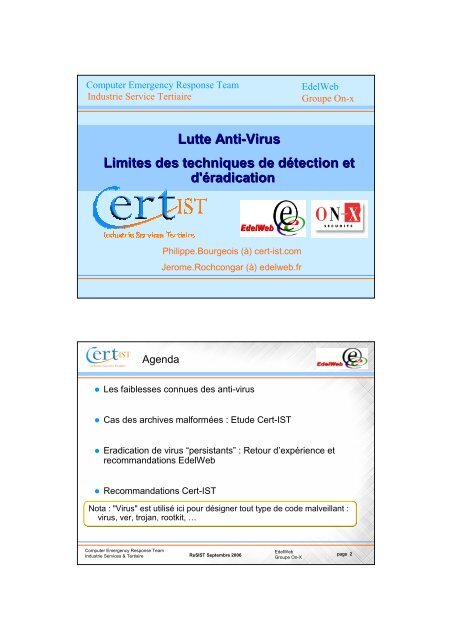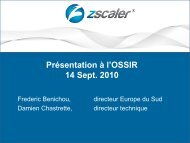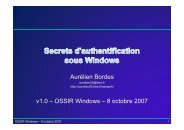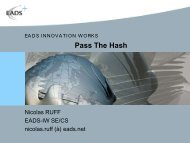Lutte Anti-Virus Limites des techniques de détection et d ... - OSSIR
Lutte Anti-Virus Limites des techniques de détection et d ... - OSSIR
Lutte Anti-Virus Limites des techniques de détection et d ... - OSSIR
You also want an ePaper? Increase the reach of your titles
YUMPU automatically turns print PDFs into web optimized ePapers that Google loves.
Computer Emergency Response TeamIndustrie Service TertiaireE<strong>de</strong>lWebGroupe On-x<strong>Lutte</strong> <strong>Anti</strong>-<strong>Virus</strong><strong>Limites</strong> <strong><strong>de</strong>s</strong> <strong>techniques</strong> <strong>de</strong> détection <strong>de</strong>td'éradicationPhilippe.Bourgeois (à) cert-ist.comJerome.Rochcongar (à) e<strong>de</strong>lweb.frAgenda Les faiblesses connues <strong><strong>de</strong>s</strong> anti-virus Cas <strong><strong>de</strong>s</strong> archives malformées : Etu<strong>de</strong> Cert-IST Eradication <strong>de</strong> virus “persistants” : R<strong>et</strong>our d’expérience <strong>et</strong>recommandations E<strong>de</strong>lWeb Recommandations Cert-ISTNota : "<strong>Virus</strong>" est utilisé ici pour désigner tout type <strong>de</strong> co<strong>de</strong> malveillant :virus, ver, trojan, rootkit, …Computer Emergency Response TeamIndustrie Services & TertiaireReSIST Septembre 2006E<strong>de</strong>lWebGroupe On-Xpage 2
Faiblesses connues <strong><strong>de</strong>s</strong> anti-virus Fonctionnent essentiellement par signatureFaiblesse intrinsèque(par conception)Reconnaissent facilement les virus déjà connusMais sont souvent aveugles face à <strong><strong>de</strong>s</strong> variantes <strong>de</strong> ces attaques Doivent traiter <strong>de</strong> multiples formats <strong>et</strong> encodagesArchives (ZIP, RAR, TGZ, <strong>et</strong>c…)Encodage Mime Ne sont pas exempts <strong>de</strong> bugs (ex : Buffer overflow)Les antivirus ne sont que <strong><strong>de</strong>s</strong> logiciels … Certains bugs impactent la sécurité :– Mise en défaut <strong>de</strong> l'antivirus (non détection <strong>de</strong> virus)– Ou même mise en danger <strong>de</strong> la plate-forme hôte (exécution <strong>de</strong> co<strong>de</strong>)Faiblesse <strong>de</strong>constructionComputer Emergency Response TeamIndustrie Services & TertiaireReSIST Septembre 2006E<strong>de</strong>lWebGroupe On-Xpage 3Faiblesses connues <strong><strong>de</strong>s</strong> anti-virus Les antivirus sont une cible d'attaque pour les co<strong><strong>de</strong>s</strong>malveillants :Désactivation <strong><strong>de</strong>s</strong> anti-virusDissimulation au moyens <strong>de</strong> « rootkits » ou <strong>de</strong> fonctions avancées<strong>de</strong> la plate-forme (exemple : ADS)Cible activementattaquée Synthèse <strong><strong>de</strong>s</strong> "stratégies" d'attaques :Neutralisation (stopper l'antivirus)Contournement (échapper à la détection)Tremplin (utiliser l'anti-virus pour infecter le système)Computer Emergency Response TeamIndustrie Services & TertiaireReSIST Septembre 2006E<strong>de</strong>lWebGroupe On-Xpage 4
Evolution du nombre d’avis Cert-ISTsur les produits anti-virus Une augmentation Emission spectaculaire d'une pré-alertes Cert-IST <strong>de</strong>puis :mi 2004• CERT-IST/DG-2005.006 (07/10/05) Les anti-virus intéressent les "chercheurs" <strong>de</strong> failles ?<strong>Virus</strong> utilisant lesarchives malformées :• Sober-X30Etu<strong><strong>de</strong>s</strong> Systèmatiques 25 :• BlackHat 2005 (BoF)• Archives malformés20(contournement)15Failles "traditionnelles" :• ZipOfDeath 10(DOS)• Entêtes MIME incorrectes(contournement)501999 2000 2001 2002 2003 2004 2005 2006Avis distincts Avis multi-produits Extrapolation sur 2006Computer Emergency Response TeamIndustrie Services & TertiaireReSIST Septembre 2006E<strong>de</strong>lWebGroupe On-Xpage 5Recherches connues surla vulnérabilité <strong><strong>de</strong>s</strong> anti-virus (1/2) Etu<strong>de</strong> 2005 par <strong><strong>de</strong>s</strong> chercheurs <strong>de</strong> ISS : Première étu<strong>de</strong> systématique dans ce domaine (reverse engineering <strong>de</strong> co<strong>de</strong>) Vulnérabilités <strong>de</strong> type « Buffer/Heap overflow » i<strong>de</strong>ntifiées dans les anti-virus :– Computer Associate, ClamAV, F-Secure, Kaspersky, McAfee, Panda,Sophos, Symantec, Trend Micro Etu<strong><strong>de</strong>s</strong> sur les archives malformées(Liste)IDefense (octobre 2004) : CAN-2004-0932 à CAN-2004-0936, CVE-2004-2442– Indiquer une taille <strong>de</strong> zéro dans l'entête ZIPfRoGGz (octobre 2005) ; CVE-2005-3210 à CVE-2005-3235– Ajouter un marqueur "MZ" en tête d'un fichier d'archive (RAR, CAB, ARJ)Andrey Bayora (octobre 2005) : The Magic of magic byte– Ajouter un marqueur "MZ" en tête <strong>de</strong> fichiers ".hmtl", ".bat" ou ".eml"Computer Emergency Response TeamIndustrie Services & TertiaireReSIST Septembre 2006E<strong>de</strong>lWebGroupe On-Xpage 6
Recherches connues surla vulnérabilité <strong><strong>de</strong>s</strong> anti-virus (2/2) Thierry Zoller :17/10/05 : RAR - Evasion of <strong>Anti</strong> <strong>Virus</strong> D<strong>et</strong>ection03/11/05 : F-Prot/Frisk <strong>Anti</strong> <strong>Virus</strong> bypass - ZIP Version Hea<strong>de</strong>r28/12/05 : New AV-Evasion M<strong>et</strong>hods - Summary– New M<strong>et</strong>hods of Evasion : 5– AV Products currently affected : 22– Gateway Solutions affected : 219/01/06 : F-Secure AV - <strong>Anti</strong>-virus Bypass and Buffer OverflowComputer Emergency Response TeamIndustrie Services & TertiaireReSIST Septembre 2006E<strong>de</strong>lWebGroupe On-Xpage 7Agenda Les faiblesses connues <strong><strong>de</strong>s</strong> anti-virus Cas <strong><strong>de</strong>s</strong> archives malformées : Etu<strong>de</strong> Cert-IST Eradication <strong>de</strong> virus “persistants” : R<strong>et</strong>our d’expérience <strong>et</strong>recommandations E<strong>de</strong>lWeb Recommandations Cert-IstComputer Emergency Response TeamIndustrie Services & TertiaireReSIST Septembre 2006E<strong>de</strong>lWebGroupe On-Xpage 8
Principe d'une archive malformée Un fichier archive "normal" est légèrement déforméEx : ajouter "MZ" en tête d'un fichier "ZIP"(Illustration) Le fichier malformé contient un virus :Il n'est plus détecté comme infecté par l'anti-virus (du fait <strong>de</strong> la malformation)Mais l'outil <strong>de</strong> décompression (WinZip, WinRar) est capable d'extraire le virus(il n'est pas gêné par la malformation) Risque ?Perm<strong>et</strong> <strong>de</strong> contourner une protection périmétrique (passerelle antivirus)Mais sera normalement stoppé sur le poste utilisateur lorsque le virus sera extrait<strong>de</strong> l'archive malformée (analyse "à l'accès")Computer Emergency Response TeamIndustrie Services & TertiaireReSIST Septembre 2006E<strong>de</strong>lWebGroupe On-Xpage 9Etu<strong>de</strong> réalisée par le Cert-IST Prolongement d'une étu<strong>de</strong> publiée par "Froggz"en octobre 2005 Construction d'un jeu <strong>de</strong> test systématiqueTrois malformations : MZ, MZ+, NullSeize formats d'archive : 7Z, ACE, ARJ, BZ2, CAB, CPIO, ISO, JAR, LHA, LZH,RAR, TAR, TGZ, UUE, XXE, ZIP Test <strong>de</strong> : Sept antivirus :Avast, ClamWin, F-Secure, Kaspersky, McAfee, Sophos, Trend Micro Quatre outils <strong>de</strong> manipulation d'archiveWinZip 9.0, PowerArchiver 9.26.02, WinRAR 3.51, Windows XPComputer Emergency Response TeamIndustrie Services & TertiaireReSIST Septembre 2006E<strong>de</strong>lWebGroupe On-Xpage 10
Résultats <strong>de</strong> l'étu<strong>de</strong> Résultats : 92 anomalies i<strong>de</strong>ntifiées15 anomalies sont préoccupantes.Exemple : Fichier ZIP malformé extractible par WinZip(Détails)Les autres anomalies sont mineures.Exemple : Fichier LZH malformé extractible par WinRar. Conclusion :Il est facile <strong>de</strong> trouver <strong><strong>de</strong>s</strong> anomalies qui perm<strong>et</strong>tent <strong>de</strong> contournerune protection antivirale périmétrique;Computer Emergency Response TeamIndustrie Services & TertiaireReSIST Septembre 2006E<strong>de</strong>lWebGroupe On-Xpage 11Recommandations Cert-IST Pourquoi l'antivirus est-il mis en échec ?Hypothèse 1 : L'AV fait entièrement confiance aux oct<strong>et</strong>s d'entêtepour déterminer la nature du fichierMZ = Exécutable le fichier n'est pas une archive ZIP.Quid <strong><strong>de</strong>s</strong> archives auto-extractibles, alors ?Hypothèse 2 : L'AV ne comprend pas la structure du fichier <strong>et</strong> déci<strong>de</strong>qu'il n'est pas dangereuxPourquoi ne pas ém<strong>et</strong>tre un avertissement : fichier non compris = fichier suspect Comment améliorer la détection ?Em<strong>et</strong>tre un avertissement (ou mise en quarantaine) sur détection d'une anomalie– Contradiction entre l'entête du fichier ("MZ") <strong>et</strong> son extension (".ZIP")– Ou toute autre anomalie dans la structure du fichierComputer Emergency Response TeamIndustrie Services & TertiaireReSIST Septembre 2006E<strong>de</strong>lWebGroupe On-Xpage 12
Réaction <strong><strong>de</strong>s</strong> éditeurs anti-virus Résultats mitigés3 ont corrigé les anomalies dans le mois qui suivait le rapport d'anomalie.2 ont corrigé dans les 6 mois suivants, après relances.2 n'ont pas pris en compte les anomalies signalées(ils sont toujours vulnérables).Computer Emergency Response TeamIndustrie Services & TertiaireReSIST Septembre 2006E<strong>de</strong>lWebGroupe On-Xpage 13Agenda Les faiblesses connues <strong><strong>de</strong>s</strong> anti-virus Cas <strong><strong>de</strong>s</strong> archives malformées : Etu<strong>de</strong> Cert-IST Eradication <strong>de</strong> virus “persistants” : R<strong>et</strong>our d’expérience <strong>et</strong>recommandations E<strong>de</strong>lWeb Recommandations Cert-ISTComputer Emergency Response TeamIndustrie Services & TertiaireReSIST Septembre 2006E<strong>de</strong>lWebGroupe On-Xpage 14
Qu’est-ce qu’un virus “persistant”? Tout type <strong>de</strong> co<strong>de</strong> malveillant (virus, ver, troyen,…) Utilise <strong><strong>de</strong>s</strong> <strong>techniques</strong> <strong>de</strong> furtivité pour se cacher Utilise <strong><strong>de</strong>s</strong> <strong>techniques</strong> sophistiquées afin d’empêcher sasuppressionDIFFICULTES <strong>de</strong> DETECTION <strong>et</strong> d’ERADICATIONComputer Emergency Response TeamIndustrie Services & TertiaireReSIST Septembre 2006E<strong>de</strong>lWebGroupe On-Xpage 15Exemple du ver Brontok (1/3) Ver apparu fin 2005 Propagation parmessagerie (pièce jointe au mail)copie sur les partages réseau <strong>et</strong> supports USB CaractéristiquesProcessus non interruptibles par les moyens propres ausystème : lancés au démarrage (même en mo<strong>de</strong> sans échec) utilisent le nom <strong>de</strong> processus systèmes (smss, lsass, ...) considérés comme légitimes,critiques <strong>et</strong> ininterruptibles par WindowsUtilisation <strong>de</strong> la ligne <strong>de</strong> comman<strong>de</strong> <strong>et</strong> <strong>de</strong> Regedit impossibleFichiers infectés <strong>et</strong> clés <strong>de</strong> registre recréés en permanenceComputer Emergency Response TeamIndustrie Services & TertiaireReSIST Septembre 2006E<strong>de</strong>lWebGroupe On-Xpage 16
Exemple du ver Brontok (2/3)Difficultés d’éradication Avec un anti-virus en mo<strong>de</strong> scan Brontok détecte le lancement d’un antivirus <strong>et</strong> effectue unredémarrage du poste Avec <strong><strong>de</strong>s</strong> outils spécifiques fournis par <strong><strong>de</strong>s</strong> éditeurs Inefficaces sur la version du ver testée Manuellement Impossible par les moyens standard Windows car :- éditeur <strong>de</strong> registre désactivé- pas d’accès à la ligne <strong>de</strong> comman<strong>de</strong>- processus non interruptibles via taskmgr ou mo<strong>de</strong> sans échec- ...Computer Emergency Response TeamIndustrie Services & TertiaireReSIST Septembre 2006E<strong>de</strong>lWebGroupe On-Xpage 17Exemple du ver Brontok (3/3)Solutions d’éradication Utilisation d’outils tiers Arrêt <strong><strong>de</strong>s</strong> processus Modification <strong><strong>de</strong>s</strong> valeurs <strong>de</strong> la base <strong>de</strong> registreRq: Le lancement <strong>de</strong> certains outils tiers entraîne un reboot Utilisation <strong>de</strong> la console <strong>de</strong> récupération <strong>de</strong> WindowsAccès au système sans que les processus du ver ne soient lancésSuppression <strong><strong>de</strong>s</strong> fichiers infectés Réinstallation du posteComputer Emergency Response TeamIndustrie Services & TertiaireReSIST Septembre 2006E<strong>de</strong>lWebGroupe On-Xpage 18
Bilan sur les virus “persistants” ImpactsIndisponibilité <strong><strong>de</strong>s</strong> postes (mise en quarantaine)Interventions sur les postes infectés (éradication ouréinstallation)Remise en état du SI coûteuse TendanceDéveloppement <strong>de</strong> ce type <strong>de</strong> co<strong><strong>de</strong>s</strong>Computer Emergency Response TeamIndustrie Services & TertiaireReSIST Septembre 2006E<strong>de</strong>lWebGroupe On-Xpage 19 PréventionRecommandations : Prise encompte <strong>de</strong> ce type <strong>de</strong> co<strong>de</strong>intégrer les évolutions <strong><strong>de</strong>s</strong> virus “persistants” à la veille antivirale <strong>et</strong> auxtests <strong><strong>de</strong>s</strong> capacités d’éradication <strong><strong>de</strong>s</strong> logiciels antivirus ProtectionM<strong>et</strong>tre en oeuvre une Protection multi-niveaux du SIUtiliser <strong><strong>de</strong>s</strong> Moyens <strong>de</strong> protection différents <strong>et</strong> complémentaires(plusieurs antivirus, filtrage, contrôle d’intégrité, paramétrage <strong><strong>de</strong>s</strong>systèmes, <strong><strong>de</strong>s</strong> applications, ...) RéactionAdapter la gestion <strong>de</strong> crise <strong>et</strong> les procédures / scénarios critiques (ex:association co<strong>de</strong> <strong>de</strong> type Blaster <strong>et</strong> capacités <strong>de</strong> persistance)Computer Emergency Response TeamIndustrie Services & TertiaireReSIST Septembre 2006E<strong>de</strong>lWebGroupe On-Xpage 20
Prise en compte <strong>de</strong> la menace liéeau co<strong>de</strong> malveillantComputer Emergency Response TeamIndustrie Services & TertiaireReSIST Septembre 2006E<strong>de</strong>lWebGroupe On-Xpage 21Recommandations :Prise en compte<strong>de</strong> la menace liée au co<strong>de</strong>malveillantMise en oeuvre d’une politique antivirale i<strong>de</strong>ntification <strong><strong>de</strong>s</strong> besoins, <strong><strong>de</strong>s</strong> moyens, <strong><strong>de</strong>s</strong> responsabilitésVeille technique <strong>Anti</strong>ciper les principales crisesApplication régulière <strong><strong>de</strong>s</strong> correctifs Diminuer la vulnérabilité <strong><strong>de</strong>s</strong> postesContrôles multi-niveaux (Passerelles HTTP, SMTP, Messagerieinterne, Serveurs <strong>de</strong> données, postes <strong>de</strong> travail)<strong>Anti</strong>virus, Firewall, contrôle d’intégrité, NIPS, HIPS Assurer l’administration <strong>et</strong> l’exploitation <strong><strong>de</strong>s</strong> moyens déployésContrôle <strong><strong>de</strong>s</strong> ordinateurs portables <strong>et</strong> supportsComputer Emergency Response TeamIndustrie Services & TertiaireReSIST Septembre 2006E<strong>de</strong>lWebGroupe On-Xpage 22
Agenda Les faiblesses connues <strong><strong>de</strong>s</strong> anti-virus Cas <strong><strong>de</strong>s</strong> archives malformées : Etu<strong>de</strong> Cert-IST Eradication <strong>de</strong> virus “persistants” : R<strong>et</strong>our d’expérience <strong>et</strong>recommandations E<strong>de</strong>lweb Recommandations Cert-ISTComputer Emergency Response TeamIndustrie Services & TertiaireReSIST Septembre 2006E<strong>de</strong>lWebGroupe On-Xpage 23Constat Le poste utilisateur est <strong>de</strong>venu la cible Nº 1 <strong><strong>de</strong>s</strong> attaquesOpportunistes (constitution <strong>de</strong> "botn<strong>et</strong>s")Ou ciblées (espionnage industriel) L'anti-virus est une protection indispensable,mais pas infaillibleIl ne protège que contre une menace déjà i<strong>de</strong>ntifiéeIl peut être parfois contournéSes capacités <strong>de</strong> désinfection peuvent être mises en défaut De plus en plus <strong>de</strong> "chercheurs" s'intéressent aux failles <strong><strong>de</strong>s</strong>anti-virusNota : la "mo<strong>de</strong>" n'est plus à publier <strong><strong>de</strong>s</strong> avis <strong>de</strong> sécurité sur Bugtraq,mais plutôt à gar<strong>de</strong>r secr<strong>et</strong> ses trouvailles.Computer Emergency Response TeamIndustrie Services & TertiaireReSIST Septembre 2006E<strong>de</strong>lWebGroupe On-Xpage 24
ConclusionPas <strong>de</strong> solution miracle ☹Mais une prise <strong>de</strong> conscience commune perm<strong>et</strong> <strong>de</strong> maintenir/renforcer les défenses Pour les organismes <strong>de</strong> veille <strong>et</strong> les expertsVigilance pour i<strong>de</strong>ntifier les nouvelles menacesAdapter les outils <strong>et</strong> procédures à ces menaces Pour les éditeurs <strong>de</strong> solutions anti-virusRéceptivité (vigilance) face aux "nouvelles" attaquesRéactivité Pour l'entreprise : une défense en profon<strong>de</strong>urNe pas se limiter à une protection périmétriqueSensibiliser les utilisateursProtéger l'information au sein <strong>de</strong> l'entrepriseComputer Emergency Response TeamIndustrie Services & TertiaireReSIST Septembre 2006E<strong>de</strong>lWebGroupe On-Xpage 25
















